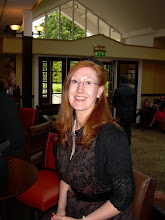 The Pushkin Museum is devoted to European Fine Arts, and is the most amazing place, containing many paintings which are familiar to me but I had assumed they were in the Louvre, or somewhere in the UK. Paying particular attention to the nineteenth century (of course!), I managed to get lost here, but it was worth it!
The Pushkin Museum is devoted to European Fine Arts, and is the most amazing place, containing many paintings which are familiar to me but I had assumed they were in the Louvre, or somewhere in the UK. Paying particular attention to the nineteenth century (of course!), I managed to get lost here, but it was worth it!Goya, Monet, Manet, Corot, Whistler, Seurrat, Van Gogh, Cezanne - so many big names here, but the gallery proved a useful reminder that it's not the names but the sheer amazingness of seeing the paintings, in the flesh (so to speak) that is important. For example, Corot's Diana Bathing is so sculptural, so cold and yet lifelike, erotic and shadowy, and it's hard to get a sense of that in a reproduction (see right). It should be a cliche, but somehow it isn't.
somehow it isn't.
 somehow it isn't.
somehow it isn't.It amused me somewhat to see Alma Tadema's Queen Fredegonda at the deathbed of Bishop Praesextatus, so English, quasi-Pre-Raphaelite, and somehow unexpected! I was also pleased to see Toulouse-Lautrec's Yvette Gilbert singing "Linger Longer Loo" (1894) (left) - it should be a caricature, almost silly, but it isn't - such expression, it appeals to me. Oh, and so many Degas' - ballet dancers, nudes - always less chocolate-box and more moving in the flesh, especially Dancer posing for a photographer - an interesting set-up. Of course, there were many artists I hadn't heard of, such as Jean-Louis Forain, whose 1880 painting Leaving the Masquerade Ball at the Grand Opera particularly interested me - it should be just a society picture, but seemed much more than that, with a mysterious twist in that the women's faces were obscured, not by masks.
that, with a mysterious twist in that the women's faces were obscured, not by masks.
 that, with a mysterious twist in that the women's faces were obscured, not by masks.
that, with a mysterious twist in that the women's faces were obscured, not by masks.Other highlights were Sisley, who manages to make French landscapes look so English (to my Anglicised eyes!), and Monet's White Water Lilies, so verdant and much less clicheed than I usually think of Monet. Also, while I'm not usually than keen on Renoir, Girls in Black (1880) is contemplative, quiet, while his 1876 Nude (right) seems to me a triumph of female sexuality over the male viewer (discuss!) Van Gogh, always so exuberant and somehow surprising, managed to surprise me again - Red Vineyard is great but The Sea at Saintes-Maries (1888) I love - such thick paint, so reminiscent of the movement of the sea. Another delight was Pierre Puvis de Chavannes The Companion (1887), which seemed almost medieval in style, perhaps reminiscent of Burne Jones's medievalism, while the male presence seems to contain a threatening sexuality despite the anodyne title of the painting. I hadn't seen before, but liked, Buffet's drawings of Notre Dame de Paris, which had an appealing symmetry, seeming to reference th draughtsmanship of an earlier age, reducing perfect architecture to a few lines without losing their beauty.
The Fauvist painter Albert Marquet was someone I hadn't come across before (more info here). His industrial cityscapes have an amazing beauty all there own - it's very much about "the painter's eye" here - and he paints water - from sea to canal - amazingly, with a visible, believable thick ness.
ness.
 ness.
ness.The highlight of the museum, though, must be the Matisses. There's a whole room of them, wonderfully vivid still lifes, which test one's perception of perspective. I still can't work out why I find them so visually satisfying, but I do. The ones here were Corner of an Artist's Studio (1912), The Pink Studio (1911) (left), Nasturtiums, La Danse II (both 1912), Goldish (1911) and Arums, Iris and Mimosa (1912) - a blaze of colour and movement. It's worth going to Moscow just for these.











No comments:
Post a Comment